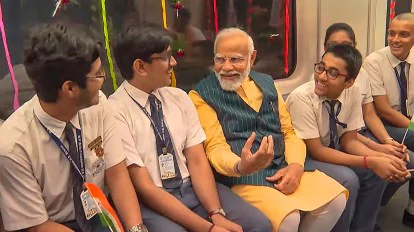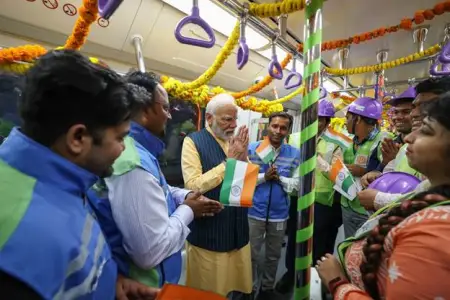Discover how PM Modi’s unveiling of multiple metro projects, including the groundbreaking Kolkata underwater corridor, promises to revolutionize urban connectivity.
Unveiling a New Era in Indian Metro Systems

In a momentous event that captured the nation’s attention, Prime Minister Narendra Modi recently unveiled a series of groundbreaking metro initiatives aimed at revolutionizing India’s transportation landscape. Among these initiatives stands the remarkable Kolkata underwater corridor, a testament to India’s commitment to modernizing its infrastructure. The inauguration of the ₹4,965-crore Howrah Maidan-Esplanade segment of Kolkata Metro’s East-West Corridor, featuring India’s premier transportation tunnel beneath a substantial river, marked a significant milestone in the country’s metro development journey.
Embarking on a Historic Metro Journey

Accompanied by schoolchildren, Prime Minister Modi embarked on a historic metro journey from Esplanade to Howrah Maidan following the inauguration ceremony. The highlight of this journey was the traverse through the under-river tunnel, spanning an impressive 520 meters. Officials estimate that trains can cover this distance in approximately 45 seconds, showcasing the efficiency and speed of India’s burgeoning metro systems.
Expanding Kolkata Metro: Connecting Communities
The inauguration event also heralded the commencement of two crucial segments within Kolkata Metro. The Kavi Subhash-Hemanta Mukhopadhyay segment of the New Garia-Airport line and the Taratala-Majerhat segment of the Joka-Esplanade line signify the expansion of the nation’s oldest metro system. Notably, the Majerhat metro station, characterized by its distinctive elevated structure over railway lines, platforms, and a canal, adds to the architectural marvels of Kolkata’s metro network.
Nationwide Metro Initiatives
Prime Minister Modi’s metro initiatives extended beyond Kolkata, encompassing key projects across the country. Inaugurations included the Duhai-Modinagar (North) segment of the Delhi-Meerut RRTS Corridor, Pune Metro’s Ruby Hall Clinic-Ramwadi stretch, Kochi Metro’s SN Junction to Tripunithura segment, and Agra Metro’s Taj East Gate-Mankameshwar section. Furthermore, the foundation stone was laid for the Pune Metro extension between Pimpri Chinchwad and Nigdi, signaling the government’s commitment to enhancing urban connectivity nationwide.
Transforming Transportation: Alleviating Congestion and Enhancing Connectivity
These metro developments are poised to alleviate road traffic congestion while providing seamless, convenient, and comfortable transportation options to commuters. The Agra Metro segment promises enhanced connectivity to historical tourist sites, while the Delhi-Meerut RRTS Corridor’s 17-km section is expected to stimulate economic activity in the NCR region. Prime Minister Modi’s vision for a modern and efficient transportation infrastructure aligns with India’s aspirations for sustainable urban development and economic growth.
Conclusion
Prime Minister Narendra Modi’s unveiling of numerous metro initiatives underscores India’s commitment to modernizing its transportation infrastructure. From the groundbreaking Kolkata underwater corridor to the expansion of metro networks across the country, these initiatives promise to transform urban mobility and enhance connectivity. As India strides towards a more sustainable and efficient transportation landscape, the metro remains at the forefront of the nation’s development journey.
FAQs (Frequently Asked Questions)
1. What is the significance of the Kolkata underwater corridor?
The Kolkata underwater corridor is a groundbreaking initiative aimed at enhancing connectivity and easing transportation congestion in the city. It symbolizes India’s commitment to modernizing its infrastructure.
2. How will the metro initiatives benefit commuters?
The metro initiatives will provide commuters with seamless, convenient, and comfortable transportation options, reducing reliance on congested road networks and promoting sustainable urban mobility.
3. What impact will the metro expansions have on economic activity?
Metro expansions, such as the Delhi-Meerut RRTS Corridor, are expected to stimulate economic activity by improving connectivity and accessibility to commercial hubs, thus fostering growth and development in the regions served by these metro networks.
4. How does the inauguration of metro stations contribute to urban development?
The inauguration of metro stations not only enhances urban connectivity but also catalyzes urban development by attracting investments, fostering commercial activity, and promoting real estate development in the vicinity of metro corridors.
5. What is the government’s vision for the future of India’s metro systems?
The government aims to further expand and modernize India’s metro systems, leveraging them as key components of sustainable urban development strategies, fostering economic growth, and improving the quality of life for citizens.
